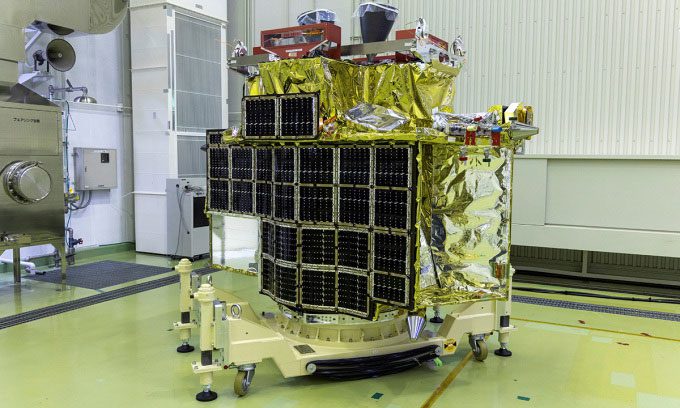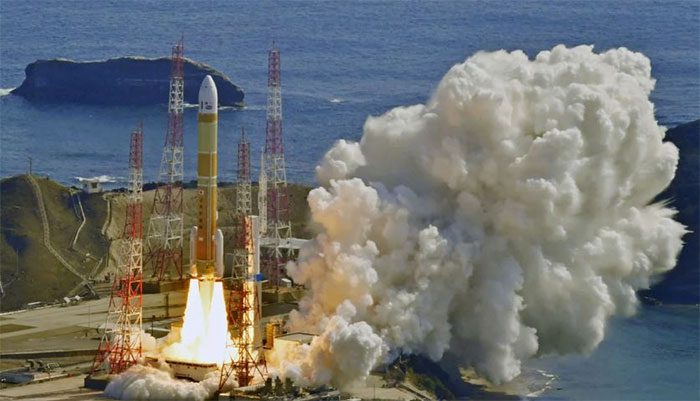Japan is the next country targeting the Moon, just days after a Russian spacecraft crashed into its surface and India’s Chandrayaan-3 landed at the South Pole.
The H-IIA rocket from the Japan Aerospace Exploration Agency (JAXA) is set to launch on the morning of August 27 from the Tanegashima Space Center, carrying an advanced imaging satellite and a lightweight lander. It is expected to land on the Moon in January or February of next year.
If successful, JAXA will gain momentum to rebuild its reputation after a series of costly failures over the past year.
Professor Jiro Kasahara from the Department of Aerospace Engineering at Nagoya University remarked that previous failures have added pressure on JAXA for this upcoming launch.
He stated that landing on a moving celestial body is an extremely critical technology that must be mastered. While other space agencies have overcome failures, JAXA will face challenges if it continues to stumble. Professor Kasahara said: “Japan has only one chance.”

Smart Lander for Investigating the Moon (SLIM) at Tanegashima Space Center on June 1. (Photo: JAXA/AFP)
Failed Launches
JAXA’s misfortunes began in October 2022, when the sixth launch of the Epsilon rocket encountered issues during flight. This rocket was carrying two satellites as part of JAXA’s first commercial contracts.
This was the first major failure of a Japanese rocket since 2003. An investigation revealed that a faulty component of the rocket prevented it from standing upright to reach orbit.
A month later, JAXA disclosed that a research team had distorted a large amount of data collected during experiments simulating life on the International Space Station (ISS).
By February 2023, the agency canceled the first launch of the H3, a new-generation rocket derived from the H-IIA, after experiencing system malfunctions between the main engine and side boosters.
Mitsubishi Heavy Industries spent nearly a decade developing the H3 – a single-use rocket aimed at providing a cheaper, more reliable alternative to competitors like SpaceX’s reusable Falcon 9.
The second launch attempt in early March ended in further disaster, as the second-stage engine of the rocket failed to ignite.
Operators sent a self-destruct command as it ascended, causing the spacecraft and its payload to plunge into the Philippine Sea.

Moment the H3 rocket launches from Tanegashima Space Center on March 7. (Photo: Reuters).
Then, in July, the engine of the Epsilon S (the seventh version of the rocket) exploded during a ground test, causing a fire that destroyed a facility in Akita Prefecture.
While no injuries were reported, the incident was a setback not only for the Epsilon line but also for the H3, as both rockets utilize the same new solid rocket booster.
JAXA Director Hiroshi Yamakawa stated at a press conference following the accident: “Considering the recent events, we are looking to do whatever we can to improve the situation.”
JAXA has limited the potential causes of the H3 incident to a faulty ignition plug or controller in the second-stage engine.
The agency aims to prevent a recurrence of the problem in its next H3 launch attempt, scheduled before the end of the current fiscal year in March 2024.
Professor Shinichi Kimura, Director of the Space System Innovation Research Center at Tokyo University of Science, commented: “Before this year, Japanese rockets had been performing well—perhaps too well—leading to certain oversights.” The launch on August 27 will provide JAXA with an opportunity to turn the tide.
He added: “It is an important mission, both scientifically and symbolically.”
Professor Kimura and Professor Kasahara are advisors to the government council investigating the H3 issues.
Startup Support
As Japanese entrepreneurs strive to build space startups, they will receive support from JAXA. Space Walker is the first private rocket company to receive funding from JAXA. The agency plans to further support more space businesses.
Notably, the most recognized company among these startups faced a setback early this year.
The Hakuto-R lander from the Tokyo-based company Ispace was just minutes away from achieving Japan’s first Moon landing in April when it lost contact with the control station on Earth. Eventually, it ran out of fuel and began free-falling during its final approach.
Ispace has announced plans to launch its second mission in early 2024 as originally scheduled.
The H-IIA – the agency’s most reliable rocket with only one failure out of 42 launches since 2001 – will carry the lunar lander, also known as SLIM, this weekend.
Standing at under 3 meters tall, this lander aims to pave the way for future lunar missions with high navigational accuracy.
The H-IIA rocket will also carry the X-Ray Imaging and Spectroscopy Mission (XRISM), a satellite that will help scientists observe plasma in stars and galaxies.


















































